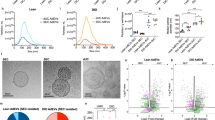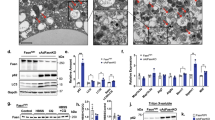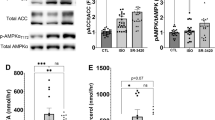Abstract
Adipocyte fatty acid-binding protein (AFABP) is an adipokine, which induces insulin resistance. However, AFABP does not possess any secretion-directed signals and the mechanisms for AFABP release have not been thoroughly assessed so far. In the current study, mechanisms for AFABP secretion were elucidated in 3T3-L1 adipocytes in vitro in the presence or absence of hormonal stimulation, calcium ionophore and secretion inhibitors by cell fractionation experiments, immunoblotting and ELISAs. We demonstrate that AFABP secretion is upregulated during adipocyte differentiation. AFABP secretion is not influenced by treatment with protein secretion inhibitors that block vesicular traffic at the endoplasmic reticulum and the Golgi apparatus. AFABP is secreted partially by adipocyte-derived microvesicles (ADMs), an established mechanism for unconventional secretion from adipocytes. Both total and ADM-secreted AFABP are downregulated by insulin and upregulated by the calcium ionophore ionomycin. Furthermore, murine RAW 264.7 macrophages secrete AFABP and AFABP release from these cells is upregulated by lipopolysaccharide treatment. Taken together, these results suggest that AFABP is actively released by unconventional mechanisms and by ADMs from 3T3-L1 adipocytes. Furthermore, AFABP secretion from fat cells is regulated by insulin and intracellular calcium.
This is a preview of subscription content, access via your institution
Access options
Subscribe to this journal
Receive 12 print issues and online access
$259.00 per year
only $21.58 per issue
Buy this article
- Purchase on Springer Link
- Instant access to full article PDF
Prices may be subject to local taxes which are calculated during checkout


Similar content being viewed by others
References
Kralisch S, Fasshauer M . Adipocyte fatty acid binding protein: a novel adipokine involved in the pathogenesis of metabolic and vascular disease? Diabetologia 2013; 56: 10–21.
Bernlohr DA, Angus CW, Lane MD, Bolanowski MA, Kelly TJ . Expression of specific messenger-Rnas during adipose differentiation - identification of an messenger-Rna encoding a homolog of myelin-P2 protein. Proc Natl Acad Sci USA Biol Sci 1984; 81: 5468–5472.
Hotamisligil GS, Johanson RS, Distel RJ, Ellis R, Papaioannou VE, Spiegelman BM . Uncoupling of obesity from insulin resistance through a targeted mutation in aP2, the adipocyte fatty acid binding protein. Science 1996; 274: 1377–1379.
Makowski L, Boord JB, Maeda K, Babaev VR, Uysal KT, Morgan MA et al. Lack of macrophage fatty-acid-binding protein aP2 protects mice deficient in apolipoprotein E against atherosclerosis. Nat Med 2001; 7: 699–705.
Furuhashi M, Tuncman G, Görgün CZ, Makowski L, Atsumi G, Vaillancourt E et al. Treatment of diabetes and atherosclerosis by inhibiting fatty-acid-binding protein aP2. Nature 2007; 447: 959–965.
Cao H, Sekiya M, Ertunc ME, Burak MF, Mayers JR, White A et al. Adipocyte lipid chaperone aP2 is a Secreted adipokine regulating hepatic glucose production. Cell Metab 2013; 17: 768–778.
Aoki N, Jin-no S, Nakagawa Y, Asai N, Arakawa E, Tamura N et al. Identification and characterization of microvesicles secreted by 3T3-L1 adipocytes: redox- and hormone-dependent induction of milk fat globule-epidermal growth factor 8-associated microvesicles. Endocrinology 2007; 148: 3850–3862.
Kralisch S, Sommer G, Weise S, Lipfert J, Lossner U, Kamprad M et al. Interleukin-1beta is a positive regulator of TIARP/STAMP2 gene and protein expression in adipocytes in vitro. FEBS Lett 2009; 583: 1196–1200.
Xie L, O’Reilly CP, Chapes SK, Mora S . Adiponectin and leptin are secreted through distinct trafficking pathways in adipocytes. Biochim Biophys Acta BBA Mol Basis Dis 2008; 1782: 99–108.
Xie L, Boyle D, Sanford D, Scherer PE, Pessin JE, Mora S . Intracellular trafficking and secretion of adiponectin is dependent on GGA-coated vesicles. J Biol Chem 2006; 281: 7253–7259.
Scherer PE, Williams S, Fogliano M, Baldini G, Lodish HF . A novel serum protein similar to C1q, produced exclusively in adipocytes. J Biol Chem 1995; 270: 26746–26749.
Hughes RC . Secretion of the galectin family of mammalian carbohydrate-binding proteins. Biochim Biophys Acta BBA Gen Subj 1999; 1473: 172–185.
Hamon Y, Luciani M-F, Becq F, Verrier B, Rubartelli A, Chimini G . Interleukin-1β secretion is impaired by inhibitors of the ATP binding cassette transporter, ABC1. Blood 1997; 90: 2911–2915.
Lamounier-Zepter V, Look C, Alvarez J, Christ T, Ravens U, Schnuck WH et al. Adipocyte fatty acid–binding protein suppresses cardiomyocyte contraction: a new link between obesity and heart disease. Circ Res 2009; 105: 326–334.
Aoki N, Yokoyama R, Asai N, Ohki M, Ohki Y, Kusubata K et al. Adipocyte-derived microvesicles are associated with multiple angiogenic factors and induce angiogenesis in vivo and in vitro. Endocrinology 2010; 151: 2567–2576.
Ogawa R, Tanaka C, Sato M, Nagasaki H, Sugimura K, Okumura K et al. Adipocyte-derived microvesicles contain RNA that is transported into macrophages and might be secreted into blood circulation. Biochem Biophys Res Commun 2010; 398: 723–729.
Ye F, Than A, Zhao Y, Goh KH, Chen P . Vesicular storage, vesicle trafficking, and secretion of leptin and resistin: the similarities, differences, and interplays. J Endocrinol 2010; 206: 27–36.
Schlottmann I, Erhart-Bornstein M, Wabitsch M, Bornstein SR, Lamounier-Zepter V . Calcium-dependent release of adipocyte fatty acid binding protein from human adipocytes. Int J Obes (Lond) 2014 doi:10.1038/ijo.2013.241.
Acknowledgements
This study was supported by grants to MF from the Deutsche Forschungsgemeinschaft (DFG, SFB 1052/1, C06), the Federal Ministry of Education and Research (BMBF), Germany, FKZ: 01EO1001 (IFB Adiposity Diseases, project K7-3 and K7-58), and the Deutsche Hochdruckliga e.V. Furthermore, TE was supported by a junior research grant by the Medical Faculty, University of Leipzig, and the Federal Ministry of Education and Research (BMBF), Germany, FKZ: 01EO1001 (IFB Adiposity Diseases, MetaRot program). We thank Stephan Lorenz for scientific insights and discussion.
Author information
Authors and Affiliations
Corresponding author
Ethics declarations
Competing interests
The authors declare no conflict of interest.
Rights and permissions
About this article
Cite this article
Kralisch, S., Ebert, T., Lossner, U. et al. Adipocyte fatty acid-binding protein is released from adipocytes by a non-conventional mechanism. Int J Obes 38, 1251–1254 (2014). https://doi.org/10.1038/ijo.2013.232
Received:
Revised:
Accepted:
Published:
Issue Date:
DOI: https://doi.org/10.1038/ijo.2013.232



